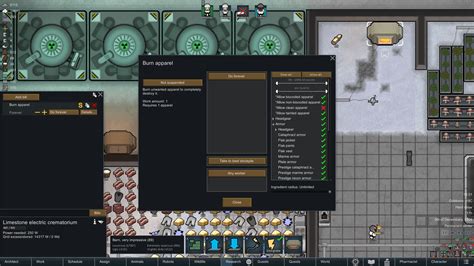RimWorld: Apparel Burning: Myths vs. Facts
RimWorld, the challenging colony simulator, presents players with numerous survival hurdles. One frequently debated aspect is apparel burning – specifically, the effectiveness (or lack thereof) and the best practices for keeping your colonists warm and dry. Let's separate the myths from the facts surrounding apparel burning in RimWorld.
What is Apparel Burning in RimWorld?
Apparel burning refers to the rapid degradation of clothing due to exposure to extreme temperatures or repeated use while colonists are heavily afflicted with conditions like hypothermia or heatstroke. This isn't a literal "burning" as in catching fire, but a rapid deterioration of the apparel's quality, rendering it ineffective or even harmful. Understanding this distinction is crucial.
Myth #1: Burning always occurs in extreme temperatures.
Fact: While extreme temperatures significantly accelerate apparel degradation, it's not the sole cause. Prolonged exposure to even moderately cold or hot environments, especially coupled with strenuous activity or illness, can lead to apparel burning. A colonist working hard in slightly cold conditions wearing thin clothing will see that clothing degrade faster than a colonist resting in a warm room.
Myth #2: All apparel burns at the same rate.
Fact: Different apparel materials have vastly different resistance to burning. Thick, high-quality materials like fur and leather are far more resistant than thin cotton or synthetic fabrics. The quality of the apparel itself also plays a role; well-made clothing will last longer than poorly crafted garments.
Myth #3: Burning apparel is always unusable.
Fact: While severely burned apparel becomes unusable, moderately damaged clothing might still offer some protection. It might, however, offer significantly less insulation than its original quality would suggest, potentially putting your colonists at risk. It's a judgment call to determine whether repairing or replacing it is the better option based on the colonist's current condition, the resources available, and the severity of the weather.
Myth #4: There's no way to prevent apparel burning.
Fact: Preventing apparel burning involves a multi-pronged approach. This includes:
- Choosing appropriate apparel: Using materials suitable for the climate and the work your colonists are performing is key.
- Maintaining good health: Keeping your colonists healthy and well-fed reduces their susceptibility to heatstroke and hypothermia, which in turn reduces apparel degradation.
- Providing sufficient shelter: Well-insulated buildings protect colonists from the elements.
- Strategic workload management: Avoid overworking colonists in extreme conditions.
- Regular apparel maintenance: Regularly repairing damaged clothing can significantly extend its lifespan.
How to Mitigate Apparel Burning
- Prioritize high-quality materials: Invest in durable clothing made from fur, leather, or other robust materials.
- Repair clothing regularly: Designate a dedicated colonist to mending damaged apparel.
- Store extra clothing: Always keep a reserve of apparel to replace damaged items.
- Use appropriate temperature control: Implement effective heating and cooling systems in your base.
- Monitor colonist conditions: Regularly check your colonists' health and adjust their work assignments accordingly.
Understanding the Impact of Temperature and Activity
The rate of apparel burning is heavily influenced by the interplay of temperature and activity levels. A colonist working hard in a hot environment will see their clothing degrade faster than a colonist resting in the same environment. Conversely, a colonist working hard in a cold environment will see a faster deterioration of their clothing than a resting colonist in the same conditions.
By understanding the complexities of apparel degradation in RimWorld and applying these strategies, you can significantly improve your colony's chances of survival and ensure your colonists remain adequately clothed and protected. Remember, proactive management and thoughtful planning are key to overcoming this common challenge.

